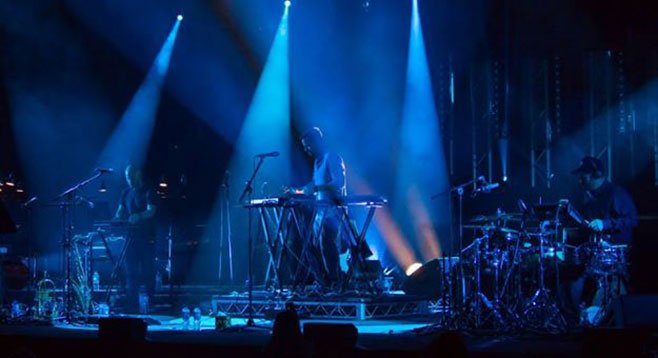 Facebook
Facebook
 X
X
 Instagram
Instagram
 TikTok
TikTok
 Youtube
Youtube

Simon Green, 38, is a British DJ/musician. He lives in New York now, but he was born in Hampshire and moved to Brighton. That’s where he began deejaying in clubs in the late ’90s. Whatever he was turning out back then got the ear of fans and industry pros in the area. Brighton is where Green says he likewise gained an education in music, meaning the analog kind. By 2000, he’d released Animal Magic. For a stage name, Green chose to identify with a chimp-like primate: the Bonobo. Curiously, Bonobos are known for their high sex drive. In 2012, for example, Psychology Today published “Seven Things Bonobos Can Teach Us About Love and Sex.” I’ve no idea whether or not that factored into Green’s decision, but I’d like to think it did.
Onstage, the Bonobo experience is all about lights and smoke. Up to a dozen musicians surround Green at his mixing table. It is trip-hop and down-tempo dance music, which is another way of saying modal music. Pianist Ahmad Jamal may have created modal music in the 1950s when he performed jazz in which basic chord progressions were absent. His melodies droned on slippery undercurrents of single chords for at least 16 measures, or in the case of Bonobo, all night. Modal music, as a guitarist friend once said of the Grateful Dead, can fold time (his words) and make you forget both the clock and the fact that you’ve been listening to stuff in the key of F sharp minor for hours. Droning along on tonal modalities, which is the property of the jam band, seems like it would be easier on a performer, but it’s not. It takes extraordinary imagination and restraint to work without the traditional sign posts of chord changes and structure. Art recycles itself: keeping it interesting enough to the average ticket-buyer is perhaps the greatest trick of all.


Simon Green, 38, is a British DJ/musician. He lives in New York now, but he was born in Hampshire and moved to Brighton. That’s where he began deejaying in clubs in the late ’90s. Whatever he was turning out back then got the ear of fans and industry pros in the area. Brighton is where Green says he likewise gained an education in music, meaning the analog kind. By 2000, he’d released Animal Magic. For a stage name, Green chose to identify with a chimp-like primate: the Bonobo. Curiously, Bonobos are known for their high sex drive. In 2012, for example, Psychology Today published “Seven Things Bonobos Can Teach Us About Love and Sex.” I’ve no idea whether or not that factored into Green’s decision, but I’d like to think it did.
Onstage, the Bonobo experience is all about lights and smoke. Up to a dozen musicians surround Green at his mixing table. It is trip-hop and down-tempo dance music, which is another way of saying modal music. Pianist Ahmad Jamal may have created modal music in the 1950s when he performed jazz in which basic chord progressions were absent. His melodies droned on slippery undercurrents of single chords for at least 16 measures, or in the case of Bonobo, all night. Modal music, as a guitarist friend once said of the Grateful Dead, can fold time (his words) and make you forget both the clock and the fact that you’ve been listening to stuff in the key of F sharp minor for hours. Droning along on tonal modalities, which is the property of the jam band, seems like it would be easier on a performer, but it’s not. It takes extraordinary imagination and restraint to work without the traditional sign posts of chord changes and structure. Art recycles itself: keeping it interesting enough to the average ticket-buyer is perhaps the greatest trick of all.
Comments